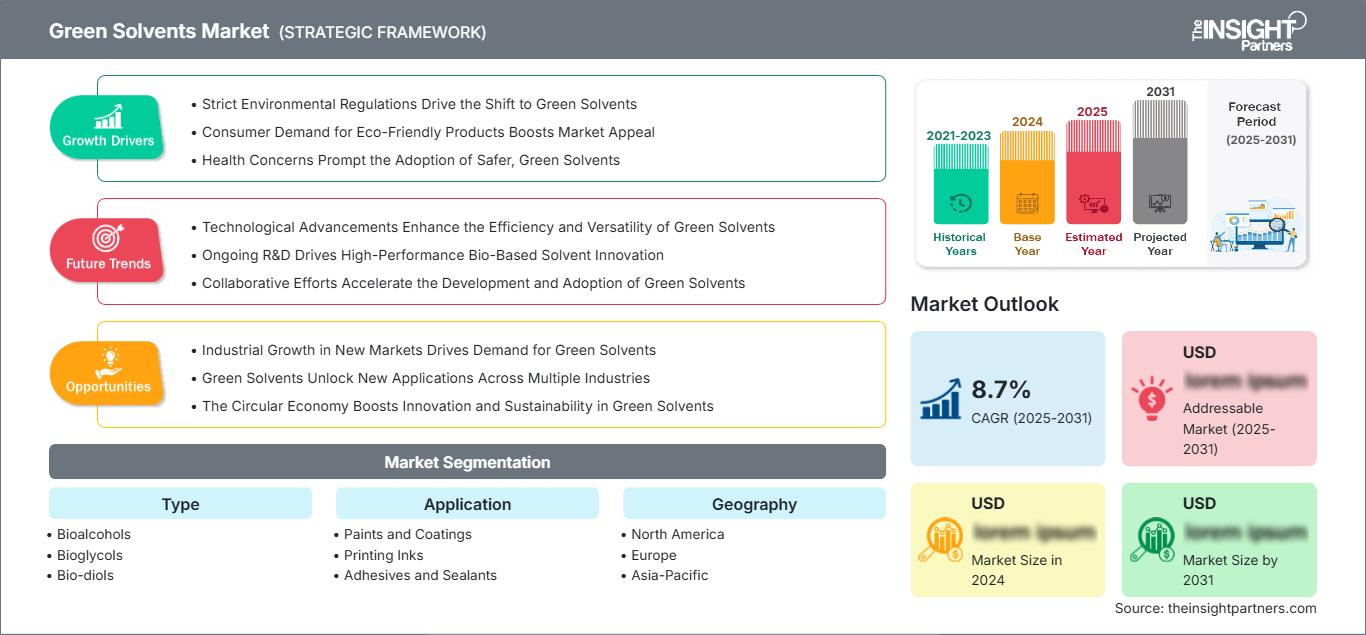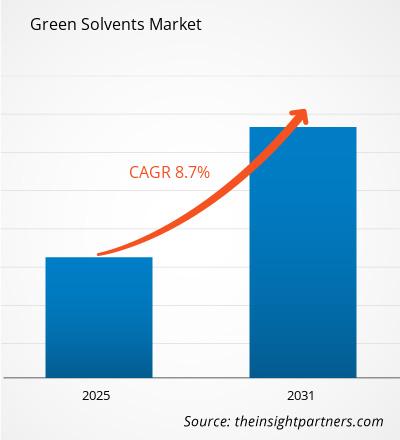Le marché des solvants verts devrait atteindre 3,7 milliards de dollars américains d'ici 2031. Il devrait enregistrer un TCAC de 8,6 % entre 2025 et 2031.
Le rapport est segmenté par type (bioalcools, bioglycols, biodiols, D-limonène, esters de lactate, solate de méthyle et autres). Il présente également une analyse par application (peintures et revêtements, encres d'imprimerie, adhésifs et mastics, cosmétiques, produits pharmaceutiques, agriculture, produits de nettoyage et autres). Le rapport couvre cinq régions : Amérique du Nord, Europe, Asie-Pacifique, Moyen-Orient et Afrique, et Amérique du Sud et centrale, ainsi que les principaux pays de chaque région. L'analyse mondiale est ensuite ventilée au niveau régional et par grands pays. Le rapport présente la valeur en USD pour l'analyse et les segments ci-dessus.
Objectif du rapport
Le rapport sur le marché des solvants verts, réalisé par The Insight Partners, vise à décrire le paysage actuel et la croissance future, les principaux facteurs de croissance, les défis et les opportunités. Il fournira des informations précieuses à divers acteurs du secteur, tels que :
- Fournisseurs de technologies/Fabricants : Pour comprendre l'évolution de la dynamique du marché et identifier les opportunités de croissance potentielles, afin de prendre des décisions stratégiques éclairées.
- Investisseurs : Pour réaliser une analyse approfondie des tendances concernant le taux de croissance du marché, les projections financières et les opportunités tout au long de la chaîne de valeur.
- Organismes de réglementation : Pour encadrer les politiques et les activités du marché afin de minimiser les abus, préserver la confiance des investisseurs et garantir l'intégrité et la stabilité du marché.
Segmentation du marché des solvants verts
- Bioalcools
- Bioglycols
- Biodiols
- D-limonène
- Esters de lactate
- Solate de méthyle
Application
- Peintures et revêtements
- Encres d'imprimerie
- Adhésifs et mastics
- Cosmétiques
- Produits pharmaceutiques
- Agriculture
- Produits de nettoyage
Vous bénéficierez d’une personnalisation sur n’importe quel rapport - gratuitement - y compris des parties de ce rapport, ou une analyse au niveau du pays, un pack de données Excel, ainsi que de profiter d’offres exceptionnelles et de réductions pour les start-ups et les universités
Marché des solvants verts: Perspectives stratégiques

-
Obtenez les principales tendances clés du marché de ce rapport.Cet échantillon GRATUIT comprendra une analyse de données, allant des tendances du marché aux estimations et prévisions.
Facteurs de croissance du marché des solvants verts
- Des réglementations environnementales strictes favorisent la transition vers les solvants verts : Les gouvernements appliquent des lois environnementales strictes et la pollution ainsi que le changement climatique doivent être éliminés. Cela contraint les industries à réduire au maximum l’utilisation de solvants nocifs. Face à cette obligation croissante, les entreprises optent pour des solvants verts dans leurs produits afin de combler les lacunes et de se conformer aux exigences.
- La demande des consommateurs pour des produits écologiques stimule l’attractivité du marché : La sensibilisation des consommateurs s’accroît et les produits verts et écologiques sont de plus en plus demandés. Les consommateurs sont davantage attirés par les marques qui prennent en compte leur responsabilité environnementale. Cette tendance a incité les fabricants à intégrer des solvants respectueux de l’environnement dans leurs formulations afin de satisfaire les consommateurs et d’améliorer l’attractivité de leurs produits et leur réputation.
- Préoccupations sanitaires favorisant l'adoption de solvants plus sûrs et écologiques : La prise de conscience croissante des risques sanitaires liés à l'utilisation des solvants traditionnels, notamment les problèmes respiratoires et les irritations cutanées, a incité les entreprises à rechercher des solutions plus respectueuses de l'environnement et moins dangereuses. La plupart des solvants écologiques sont classés comme non toxiques et moins dangereux ; ils constituent donc une excellente option pour les entreprises soucieuses de la santé et du bien-être de leurs employés.
Tendances futures du marché des solvants écologiques
- Les progrès technologiques améliorent l'efficacité et la polyvalence des solvants écologiques : Les progrès technologiques transforment le marché des solvants écologiques, conférant aux solvants biosourcés une meilleure efficacité et une plus grande polyvalence. L'amélioration des performances, l'élargissement du champ d'application et les réductions de coûts potentielles favorisent encore davantage leur adoption, notamment dans les peintures, les revêtements et les produits pharmaceutiques.
- La R&D continue stimule l'innovation dans le domaine des solvants biosourcés haute performance : par exemple, les solvants verts bénéficient d'investissements importants en recherche et développement, ce qui se traduit par une amélioration continue de leur formulation et de leur fonctionnalité. Cette tendance favorise la création d'alternatives haute performance répondant aux normes industrielles. La R&D est essentielle à la pérennité des entreprises, car elle permet de découvrir de nouveaux matériaux biosourcés et de renforcer leur compétitivité sur le marché grâce à l'amélioration et à l'innovation dans de multiples secteurs.
- La collaboration accélère le développement et l'adoption des solvants verts : ces applications des solvants verts sont également soutenues par le renforcement des partenariats industriels, universitaires et gouvernementaux, qui contribuent à accélérer leur développement et leur adoption. Ces partenariats facilitent l'apprentissage mutuel et la mise en commun des ressources, rendant ainsi possible la commercialisation de ces solutions innovantes. Les efforts de collaboration se sont également révélés être des moyens de faciliter l'accès au financement et de catalyser la transition vers des pratiques durables à mesure que le marché des solvants verts se développe.
Opportunités du marché des solvants verts
- La croissance industrielle sur les nouveaux marchés stimule la demande de solvants verts : L'industrialisation rapide des nouveaux marchés offre d'immenses opportunités pour l'utilisation des solvants verts. Les industries régionales, confrontées à une réglementation environnementale stricte, adopteront des pratiques durables et exigeront de plus en plus d'alternatives plus propres. Les entreprises peuvent tirer parti de cette tendance en proposant des solutions innovantes à base de solvants verts, adaptées aux industries locales et aux préférences des consommateurs.
- Les solvants verts ouvrent la voie à de nouvelles applications dans de nombreux secteurs : Les solvants verts offrent d'innombrables nouvelles applications, notamment dans les peintures et revêtements, les produits pharmaceutiques et les produits agrochimiques. Alors que les entreprises examinent les alternatives durables à privilégier, elles peuvent être amenées à découvrir de nouvelles applications et formulations à base de solvants verts, élargissant ainsi leur gamme de produits et s'implantant sur des marchés de niche où consommateurs et entreprises privilégient les solutions plus écologiques.
- L'économie circulaire stimule l'innovation et la durabilité des solvants verts : L'économie circulaire offre aux fabricants de solvants verts de nouvelles opportunités de développement en créant des offres plus durables. Bien qu'elle vise principalement des pratiques durables telles que le recyclage et la réduction des déchets, elle incite les entreprises à aligner leurs offres sur des objectifs écologiques plus ambitieux. Cet engagement leur permet d'améliorer leur image de marque, d'attirer une clientèle soucieuse de l'environnement et d'innover dans le développement de produits durables.
Marché des solvants verts
Les analystes de The Insight Partners ont analysé en détail les tendances régionales et les facteurs influençant le marché des solvants verts tout au long de la période de prévision. Cette section aborde également les segments et la répartition géographique du marché de la gestion des troubles du rythme cardiaque en Amérique du Nord, en Europe, en Asie-Pacifique, au Moyen-Orient et en Afrique, ainsi qu'en Amérique du Sud et centrale.
Portée du rapport sur le marché des solvants verts
| Attribut de rapport | Détails |
|---|---|
| Taille du marché en 2024 | US$ XX Billion |
| Taille du marché par 2031 | US$ 3.7 Billion |
| TCAC mondial (2025 - 2031) | 8.6% |
| Données historiques | 2021-2023 |
| Période de prévision | 2025-2031 |
| Segments couverts |
By Type
|
| Régions et pays couverts |
Amérique du Nord
|
| Leaders du marché et profils d'entreprises clés |
|
Densité des acteurs du marché des solvants verts : comprendre son impact sur la dynamique commerciale
Le marché des solvants verts connaît une croissance rapide, portée par une demande croissante des utilisateurs finaux, elle-même alimentée par l'évolution des préférences des consommateurs, les progrès technologiques et une meilleure connaissance des avantages du produit. Face à cette demande grandissante, les entreprises élargissent leur offre, innovent pour répondre aux besoins des consommateurs et tirent parti des tendances émergentes, ce qui stimule davantage la croissance du marché.

- Obtenez le Marché des solvants verts Aperçu des principaux acteurs clés
Points clés de vente
- Couverture exhaustive : Ce rapport analyse en détail les produits, services, types et utilisateurs finaux du marché des solvants verts, offrant ainsi une vision globale.
- Analyse d'experts : Ce rapport repose sur l'expertise approfondie d'analystes et de spécialistes du secteur.
- Informations actualisées : Grâce à sa couverture des informations et tendances les plus récentes, ce rapport garantit la pertinence de vos analyses.
- Options de personnalisation : Ce rapport peut être personnalisé pour répondre aux besoins spécifiques de chaque client et s'adapter parfaitement à ses stratégies commerciales.
Ce rapport d'étude de marché sur les solvants verts peut donc vous aider à décrypter et comprendre le contexte sectoriel et les perspectives de croissance. Malgré quelques points à améliorer, les avantages de ce rapport l'emportent généralement sur les inconvénients.
- Analyse historique (2 ans), année de base, prévision (7 ans) avec TCAC
- Analyse PEST et SWOT
- Taille du marché Valeur / Volume - Mondial, Régional, Pays
- Industrie et paysage concurrentiel
- Ensemble de données Excel
Rapports récents
Témoignages
Raison d'acheter
- Prise de décision éclairée
- Compréhension de la dynamique du marché
- Analyse concurrentielle
- Connaissances clients
- Prévisions de marché
- Atténuation des risques
- Planification stratégique
- Justification des investissements
- Identification des marchés émergents
- Amélioration des stratégies marketing
- Amélioration de l'efficacité opérationnelle
- Alignement sur les tendances réglementaires






















 Obtenez un échantillon gratuit pour - Marché des solvants verts
Obtenez un échantillon gratuit pour - Marché des solvants verts